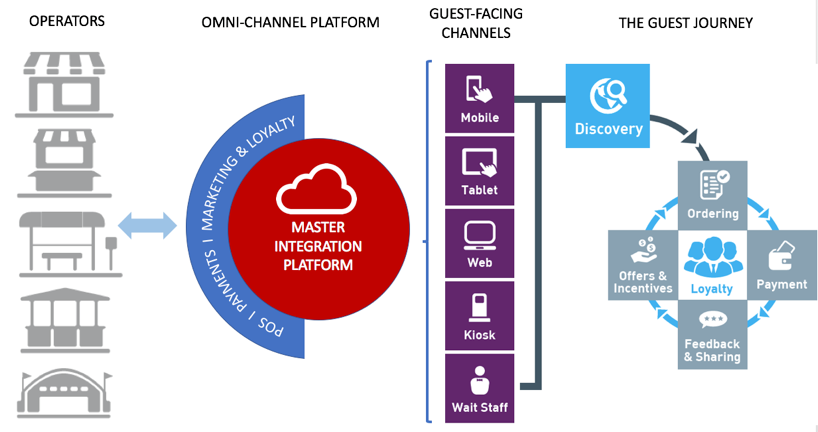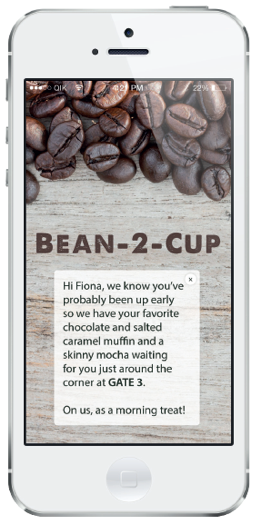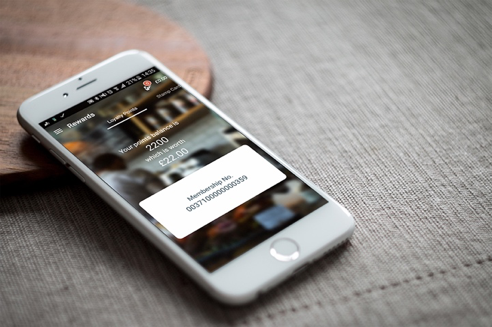One platform to rule them all
As we covered in our last blog (3 reasons why a platform approach is the only answer to your digital strategy dilemmas), brands are recognising the need for a better, simpler way of managing their complex mix of non-integrated back end systems. In a recent study by Oracle and MCA, having enough time and integration came across as the 2 main frustrations for leaders in the restaurant sector. By moving to one master integration platform, you’ll be able to harness the power of your POS, existing CRM systems and databases, payment solutions, marketing and loyalty platforms and more. This allows each system to let their particular, specialized functionality loose on the front end for the customer’s benefit.
As a CMO or CXO, what exactly does that mean for the guest experience? With a fully integrated back-end environment, you’ll be able to take greater advantage of all your back-end systems and channel them into creating a better, richer guest experience. You’ll be able to identify high value customers from your CRM, issue highly personalized and targeted offers to them via their channel of preference (mobile, web etc), track when they redeem the offer through integrated payment and POS systems which then automatically updates the loyalty platform.
In this scenario, the customer can enjoy a much more convenient journey using their channel of choice. And, importantly, their experience of your brand is consistent whether they decide to interact with you through mobile, web, kiosk or tablet. The guest experience is made even better by the fact that the context of their interaction or transaction is maintained regardless of channel meaning they can start their journey on their mobile and finish it on a kiosk in-store if they wish, giving them more choice and control over their experience.
With that single, master integrator platform in place, here are 5 ways you as the CMO/CXO can use it to drive smarter, richer experiences for your customers:
1. One brand with broad channel choice
Another huge customer experience benefit of a back-end platform approach is that the customer no longer has to consider the various channels they interact with you in as separate. As mentioned above, the customer can chop and change between mobile, kiosk, web and tablet without having to restart their journey on each new device they move to (see the diagram below on how that all fits together).
For you as the brand, a master integration platform means you can turn channels on and off as it fits your business needs or as it fits your brand or persona. If you feel web and mobile order and pay suits your service model at this time, they can be switched on and kiosk and tablet options are open to you in the future. Again, by taking more of a platform approach vs. channel play, your brand experience will enjoy more consistency and operationally, your various channels will be much easier to manage.

2. A full, consistent brand experience
Again, related to the point above, having one Content Management System to control the content across all digital channels and stores ensures that your customers can enjoy the full brand experience you’ve worked so hard to build. From logos and colours to the look and feel of the user interface and the even down to the actual customer journey – when it’s all controlled from one central position, you can be sure that customers are experiencing each carefully thought out aspect of your brand regardless of how they choose to interact and transact with you.
As the operator, being able have one single point to management content that is push out to each digital channel means easier, more efficient management and gives you more control over your brand and how your customers experience it.
3. Smarter marketing
 Now we get to the smart part of the customer experience. By opting for an integrated, platform approach, you can finally close the loop between your guest facing self-service solutions, POS and marketing and loyalty systems.
Now we get to the smart part of the customer experience. By opting for an integrated, platform approach, you can finally close the loop between your guest facing self-service solutions, POS and marketing and loyalty systems.
For example, if a customer chooses to use their mobile to place and order and pay, over time, you can gather large amounts of information about them. What their average order size is, whether they tend to place a single order or group orders as a family for examples, what time of day and what stores they like to order at and even down to the finer details such as how they like their food customized and cooked. This information can be access through mobile, stored in your CRM system, capitalized on by your marketing and loyalty solution and enabled by your POS.
Imagine you have a customer and they’re late for work but desperate for a morning coffee and snack. As a brand, you can geo-locate your customer through their mobile and push a highly personalized offer straight to their phone: “Morning Tom, we’re just around the corner, why not pop in for your favorite – a free double espresso when you buy a white chocolate and raspberry muffin?” From past behavior, you know Tom tends to shop at that specific store, that he tends to order a double espresso and white chocolate muffin but you’ve not seen him for a few weeks. It’s a compelling offer to get Tom back in your store and dining with you again and it’s all made possible by fully integrating your back-end systems.
4. More Personalized loyalty
 In a similar way to smarter marketing, a platform approach also offers smarter loyalty. Rather than taking a blanket approach to your customer base, you can start segmenting customers by value offering the most loyal and highest value customers better perks with your tiered loyalty program. As with marketing campaigns, you can gather highly personalized information about your customers and use it to power a more tailored loyalty experience.
In a similar way to smarter marketing, a platform approach also offers smarter loyalty. Rather than taking a blanket approach to your customer base, you can start segmenting customers by value offering the most loyal and highest value customers better perks with your tiered loyalty program. As with marketing campaigns, you can gather highly personalized information about your customers and use it to power a more tailored loyalty experience.
For example, monetary incentives might work well with some loyal customers but invitation to exclusive events or collecting points for other perks might work better with others. The more information you can gather about your guests – whether it’s through web, mobile or tablet – the better your loyalty program becomes as you offer a more valuable experience, leading to greater loyalty and healthier revenues.
5. Convenience is king
From payments to queue-busting – a consolidated back end can help make the experience so more convenient for your customers. For example, if your mobile app, POS and queue management system are all integrated, your guests will be able to order and pay through their mobile without the need to flag down busy wait staff. Your POS will show the table has been closed off so staff can reset it and your queue management system can be updated so waiting guests can be informed of their new wait time.
In a recent survey we conducted about queuing habits of customers, we found that 92% of guests would be more inclined to wait for a table if there was clear communications or alerts about how long their wait would be. In our Dine and Dash research, we found that a staggering 12% of diners have left without paying for their bill with the top reason for leaving being having to wait too long for staff. So the convenience factor for diners shouldn’t really be viewed as a ‘nice to have’ it has a direct and significant impact on your revenues.
By ensuring back end systems like POS, payments and CRM can talk to each other and can be represented in the front end, you can also ensure your customers have the best, most convenient experience possible avoiding the dangers poor customer service has on your bottom line.
So centralize that intelligence. Pull in information from what once were separate databases to inform activities such as marketing and even operations. As well as this powerful integrated environment, operators will also be able to turn front end channels on and off as they grow, configure features of their app as required, scale up or down according to their businesses’ needs, bring consistency across their estate and enjoy faster deployment of new functionality.
Secure that competitive edge and integrate to innovate using the power of the cloud to make it all possible. Not least, it might even save some of your more impatient customers from a life of dine and dash crime!




